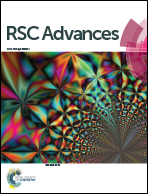Predicting the binding properties of single walled carbon nanotubes (SWCNT) with an ADP/ATP mitochondrial carrier using molecular docking, chemoinformatics, and nano-QSBR perturbation theory†
Abstract
Interactions between the single walled carbon nanotube (SWCNT) family and a mitochondrial ADP/ATP carrier (ANT-1) were evaluated using constitutional (functional groups, number of carbon atoms, etc.) and electronic nanodescriptors defined by (n, m)-Hamada indexes (armchair, zig-zag and chiral). The Free Energy of Binding (FEB) was determined by molecular docking simulation and the results showed that FEB was statistically more negative (p < 0.05), following the order SWCNT-COOH > SWCNT-OH > SWCNT, suggesting that polar groups favor the anchorage to ANT-1. In this regard, it was showed that key ANT-1 amino acids (Arg 79, Asn 87, Lys 91, Arg 187, Arg 234 and Arg 279) responsible for ADP-transport were conserved in ANT-1 from different species examined to predict SWCNT interactions, including shrimp Litopenaeus vannamei and fish Danio rerio commonly employed in ecotoxicology. The SWCNT-ANT-1 inter-atomic distances for the key ANT-1 amino acids were similar to that with carboxyatractyloside, a classical inhibitor of ANT-1. Significant linear relationships between FEB and n-Hamada index were found for zig-zag SWCNT and SWCNT-COOH (R2 = 0.95 in both cases). A Perturbation Theory-Nano-Quantitative Structure-Binding Relationship (PT-NQSBR) model was fitted that was able to distinguish between strong (FEB < −14.7 kcal mol−1) and weak (FEB ≥ −14.7 kcal mol−1) SWCNT–ANT-1 interactions. A simple ANT-1-inhibition respiratory assay employing mitochondria suspension from L. vannamei, showed good accordance with the predicted model. These results indicate that this methodology can be employed in massive virtual screenings and used for making regulatory decisions in nanotoxicology.



 Please wait while we load your content...
Please wait while we load your content...